Numerical Study on the Generation and Transport of Spume Droplets in Wind over Breaking Waves
Abstract
:1. Introduction
2. Numerical Methods and Simulation Cases
2.1. Fluid Flow Solver
2.2. Lagrangian Particle-Tracking Method
2.3. Generation of Spume Droplets
2.4. Simulation Cases and Parameters
3. Results
4. Discussion
5. Conclusions
Supplementary Materials
Acknowledgments
Author Contributions
Conflicts of Interest
Abbreviations
| MABL | Marine atmosphere boundary layer |
| LPT | Lagrangian particle tracking |
| DNS | Direct numerical simulation |
| LS | Level-set |
| VOF | Volume of fluid |
| CLSVOF | Coupled level-set and volume-of-fluid |
| LES | Large eddy simulation |
| SSGF | Sea spray generation function |
References
- Andreas, E.L. Spray stress revisited. J. Phys. Oceanogr. 2004, 34, 1429–1440. [Google Scholar] [CrossRef]
- Mueller, J.A.; Veron, F. Impact of sea spray on air-sea fluxes. Part II: Feedback effects. J. Phys. Oceanogr. 2014, 44, 2835–2853. [Google Scholar] [CrossRef]
- Iida, N.; Toba, Y. Effect of sea-water droplets on evaporation from sea surface. In The Wind-Driven Air-Sea Interface; Banner, M., Ed.; School of Mathematics, University of South Wales: Sydney, Australia, 1999; pp. 325–332. [Google Scholar]
- Edson, J.; Paluszkiewicz, T.; Sandgathe, S.; Vincent, L.; Goodman, L.; Curtin, T.; Hollister, J.; Colton, M. Coupled Marine Boundary Layers and Air-Sea Interaction Initiative: Combining Process Studies, Simulations, and Numerical Models (Revision 5.0); Office of Naval Research: Arlington, TX, USA, 1999; pp. 41–45. [Google Scholar]
- Spiel, D.E. On the birth of film drops from bubbles on seawater surface. J. Geophys. Res. Oceans 1998, 103, 24907–24918. [Google Scholar] [CrossRef]
- O’Dowd, C.D.; de Leeuw, G. Marine aerosol production; A review of the current knowledge. Philos. Trans. R. Soc. Lond. Ser. A 2007, 365, 1753–1774. [Google Scholar] [CrossRef] [PubMed]
- Fuentes, E.; Coe, H.; Green, D.; de Leeuw, G.; McFiggans, G. Laboratory-generated primary marine aerosol via bubble-bursting and atomization. Atmos. Meas. Tech. 2010, 3, 141–162. [Google Scholar] [CrossRef]
- Monahan, E.C.; Spiel, D.E.; Davidson, K.L. A model of marine aerosol generation via whitecaps and wave disruption. In Oceanic Whitecaps; Springer: Dordrecht, The Netherlands, 1986; pp. 167–174. [Google Scholar]
- Kientzler, C.F.; Arons, A.B.; Blanchard, D.C.; Woodcock, A.H. Photographic investigation of the projection of droplets by bubbles bursting at a water surface. Tellus 1954, 6, 1–7. [Google Scholar] [CrossRef]
- MacIntyre, F. Flow patterns in breaking bubbles. J. Geophys. Res. 1972, 77, 5211–5228. [Google Scholar] [CrossRef]
- Spiel, D.E. More on the births of jet drops from bubbles bursting on seawater surfaces. J. Geophys. Res. Oceans 1997, 102, 5815–5821. [Google Scholar] [CrossRef]
- Andreas, E.L. A review of the sea spray generation function for the open ocean. In Atmosphere-Ocean Interactions; Perrie, W.A., Ed.; WIT Press: Southampton, UK, 2002; pp. 1–46. [Google Scholar]
- Wu, J. Production of spume drops by the wind tearing of wave crests: The search for quantification. J. Geophys. Res. Oceans 1993, 98, 18221–18227. [Google Scholar] [CrossRef]
- Andreas, E.L.; Edson, J.; Monahan, E.B.; Rouault, M.C.; Smith, S.D. The spray contribution to net evaporation from the sea: A review of recent progress. Bound.-Layer Meteorol. 1995, 72, 3–52. [Google Scholar] [CrossRef]
- Marmottant, P.; Villermaux, E. On spray formation. J. Fluid Mech. 2004, 498, 73–111. [Google Scholar] [CrossRef]
- Veron, F. Ocean Spray. Annu. Rev. Fluid Mech. 2015, 47, 507–538. [Google Scholar] [CrossRef]
- Preobrazhenskii, L. Estimate of the content of spray drops in the near-water layer of the atmosphere. Fluid Mech. Sov. Res. 1973, 2, 95–100. [Google Scholar]
- Koga, M. Direct production of droplets from breaking wind-wave—Its observation by a multi-colored overlapping exposure photographing technique. Tellus 1981, 33, 552–563. [Google Scholar] [CrossRef]
- Andreas, E.L. Sea spray and the turbulent air-sea heat fluxes. J. Geophys. Res. Oceans 1992, 97, 11429–11441. [Google Scholar] [CrossRef]
- Andreas, E.L. A new sea spray generation function for wind speeds up to 32 ms−1. J. Phys. Oceanogr. 1998, 28, 2175–2184. [Google Scholar] [CrossRef]
- Fairall, C.W.; Kepert, J.D.; Holland, G.J. The effect of sea spray on surface energy transports over the ocean. Glob. Atmos. Ocean Syst. 1994, 2, 121–142. [Google Scholar]
- Veron, F.; Hopkins, C.; Harrison, E.L.; Muelluer, J.A. Sea spray spume droplet production in high wind speeds. Geophys. Res. Lett. 2012, 39, L16602. [Google Scholar] [CrossRef]
- Smith, M.H.; Park, P.M.; Consterdine, I.E. Marine aerosol concentrations and estimated fluxes over the sea. Q. J. R. Meteorol. Soc. 1993, 119, 809–824. [Google Scholar] [CrossRef]
- Zhao, D.; Toba, Y.; Sugioka, K.I.; Komori, S. New sea spray generation function for spume droplets. J. Geophys. Res. Oceans 2006, 111. [Google Scholar] [CrossRef]
- Mueller, J.A.; Veron, F. A sea state dependent spume generation function. J. Phys. Oceanogr. 2009, 39, 2363–2372. [Google Scholar] [CrossRef]
- Shi, J.; Zhao, D.; Li, X.; Zhong, Z. New wave-dependent formulae for sea spray flux at air-sea interface. J. Hydrodyn. Ser. B 2009, 21, 573–581. [Google Scholar] [CrossRef]
- Kudryavtsev, V.N. On the effect of sea drops on the atmospheric boundary layer. J. Geophys. Res. Oceans 2006, 111. [Google Scholar] [CrossRef]
- Ovadnevaite, J.; de Leeuw, G.; Ceburnis, D.; Monahan, C.; Partanen, A.I.; Korhonen, H.; O’Dowd, C.D. A sea spray aerosol flux parameterization encapsulating wave state. Atmos. Chem. Phys. 2014, 14, 1837–1852. [Google Scholar] [CrossRef] [Green Version]
- Kudryavtsev, V.N.; Makin, V.K. Impact of ocean spray on the dynamic of the marine atmospheric boundary layer. Bound.-Layer Meteorol. 2011, 140, 383–410. [Google Scholar] [CrossRef]
- Rastigejev, Y.; Suslov, S.A.; Lin, Y.L. Effect of ocean spray on vertical momentum transport under high-wind conditions. Bound.-Layer Meteorol. 2011, 141, 1–20. [Google Scholar] [CrossRef]
- Rastigejev, Y.; Suslov, S.A. E-ϵ model of spray-laden near-sea atmospheric layer in high wind conditions. J. Phys. Oceanogr. 2014, 44, 742–763. [Google Scholar] [CrossRef]
- Wu, L.; Rutgersson, A.; Sahlée, E.; Larsén, X.G. The impact of waves and sea spray on modelling storm track and development. Tellus A Dyn. Meteorol. Oceanogr. 2015, 67, 27967. [Google Scholar] [CrossRef] [Green Version]
- Zhang, T.; Song, J.; Li, S.; Yang, L. The effects of wind-driven waves and ocean spray on the drag coefficient and near-surface wind profiles over the ocean. Acta Oceanol. Sin. 2016, 35, 79–85. [Google Scholar] [CrossRef]
- Rastigejev, Y.; Suslov, S.A. Two-temperature nonequilibrium model of a marine boundary layer laden with evaporating ocean spray under high-wind conditions. J. Phys. Oceanogr. 2016, 46, 3083–3102. [Google Scholar] [CrossRef]
- Ortiz-Suslow, D.G.; Haus, B.K.; Mehta, S.; Laxague, N.J. A laboratory study of spray generation in high winds. In IOP Conference Series: Earth and Environmental Science; IOP Publishing: Bristol, UK, 2016; Volume 35. [Google Scholar]
- Ortiz-Suslow, D.G.; Haus, B.K.; Mehta, S.; Laxague, N.J. Sea spray generation in very high winds. J. Atmos. Sci. 2016, 73, 3975–3995. [Google Scholar] [CrossRef]
- Troitskaya, Y.; Kandaurov, A.; Ermakova, O.; Kozlov, D.; Sergeev, D.; Zilitinkevich, S. Bag-breakup fragmentation as the dominant mechanism of sea-spray production in high winds. Sci. Rep. 2017, 7, 1614. [Google Scholar] [CrossRef] [PubMed]
- Richter, D.H.; Sullivan, P.P. Sea surface drag and the role of spray. Geophys. Res. Lett. 2013, 40, 656–660. [Google Scholar] [CrossRef]
- Richter, D.H.; Sullivan, P.P. Momentum transfer in a turbulent, particle-laden Couette flow. Phys. Fluids 2013, 25, 053304. [Google Scholar] [CrossRef]
- Richter, D.H.; Sullivan, P.P. The sea spray contribution to sensible heat flux. J. Atmos. Sci. 2014, 71, 640–654. [Google Scholar] [CrossRef]
- Druzhinin, O.A.; Troitskaya, Y.I.; Zilitinkevich, S.S. The study of droplet-laden turbulent airflow over waved water surface by direct numerical simulation. J. Geophys. Res. Oceans 2017, 122, 1789–1807. [Google Scholar] [CrossRef]
- Banner, M.L.; Peregrine, D.H. Wave breaking in deep water. Annu. Rev. Fluid Mech. 1993, 25, 373–397. [Google Scholar] [CrossRef]
- Sullivan, P.P.; McWilliams, J.C. Dynamics of winds and currents coupled to surface waves. Annu. Rev. Fluid Mech. 2010, 42, 19–42. [Google Scholar] [CrossRef]
- Perlin, M.; Choi, W.; Tian, Z. Breaking waves in deep and intermediate waters. Annu. Rev. Fluid Mech. 2013, 45, 115–145. [Google Scholar] [CrossRef]
- Lamb, K.G. Internal wave breaking and dissipation mechanisms on the continental slope/shelf. Annu. Rev. Fluid Mech. 2014, 46, 231–254. [Google Scholar] [CrossRef]
- Harlow, F.H.; Welch, J.E. Numerical calculation of time-dependent viscous incompressible flow of fluid with free surface. Phys. Fluids 1965, 8, 2182–2189. [Google Scholar] [CrossRef]
- Miyata, H.; Nishimura, S.; Masuko, A. Finite difference simulation of nonlinear waves generated by ships of arbitrary three-dimensional configuration. J. Comput. Phys. 1985, 60, 391–436. [Google Scholar] [CrossRef]
- Miyata, H. Finite-difference simulation of breaking waves. J. Comput. Phys. 1986, 65, 179–214. [Google Scholar] [CrossRef]
- Osher, S.; Sethian, J.A. Fronts propagating with curvature-dependent speed: Algorithms based on Hamilton-Jacobi formulations. J. Comput. Phys. 1988, 79, 12–49. [Google Scholar] [CrossRef]
- Sussman, M.; Smereka, P.; Osher, S. A level set approach for computing solutions to incompressible two-phase flow. J. Comput. Phys. 1994, 114, 146–159. [Google Scholar] [CrossRef]
- Zhang, Y.; Zou, Q.; Greaves, D. Numerical simulation of free-surface flow using the level-set method with global mass correction. Int. J. Numer. Methods Fluids 2010, 63, 651–680. [Google Scholar] [CrossRef]
- Scardovelli, R.; Zaleski, S. Direct numerical simulation of free-surface and interfacial flow. Annu. Rev. Fluid Mech. 1999, 31, 567–603. [Google Scholar] [CrossRef]
- Lopez, J.; Hernandez, J.; Gomez, P.; Faura, F. An improved PLIC-VOF method for tracking thin fluid structures in incompressible two-phase flows. J. Comput. Phys. 2005, 208, 51–74. [Google Scholar] [CrossRef]
- Weymouth, G.D.; Yue, D.K. Conservative volume-of-fluid method for free-surface simulations on Cartesian-grids. J. Comput. Phys. 2010, 229, 2853–2865. [Google Scholar] [CrossRef]
- Sussman, M.; Puckett, E.G. A coupled level set and volume-of-fluid method for computing 3D and axisymmetric incompressible two-phase flows. J. Comput. Phy. 2000, 162, 301–337. [Google Scholar] [CrossRef]
- Lv, X.; Zou, Q.; Zhao, Y.; Reeve, D. A novel coupled level set and volume of fluid method for sharp interface capturing on 3D tetrahedral grids. J. Comput. Phys. 2010, 229, 2573–2604. [Google Scholar] [CrossRef]
- Liu, Y. Numerical Study of Strong Free Surface Flow and Breaking Waves. Ph.D Thesis, The Johns Hopkins University, Baltimore, MD, USA, 2012. [Google Scholar]
- Chen, G.; Kharif, C.; Zaleski, S.; Li, J. Two-dimensional Navier-Stokes simulation of wave breaking. Phys. Fluids 1999, 11, 121–133. [Google Scholar] [CrossRef] [Green Version]
- Song, C.; Sirviente, A.I. A numerical study of breaking waves. Phys. Fluids 2004, 16, 2649–2667. [Google Scholar] [CrossRef]
- Iafrati, A. Numerical study of the effects of the breaking intensity on wave breaking flows. J. Fluid Mech. 2009, 622, 371–411. [Google Scholar] [CrossRef]
- Hu, Y.; Guo, X.; Lu, X.; Liu, Y.; Dalrymple, R.A.; Shen, L. Idealized numerical simulation of breaking water wave propagating over a viscous mud layer. Phys. Fluids 2012, 24, 112104. [Google Scholar] [CrossRef]
- Deike, L.; Popinet, S.; Melville, W.K. Capillary effects on wave breaking. J. Fluid Mech. 2015, 769, 541–569. [Google Scholar] [CrossRef]
- Lubin, P.; Glockner, S. Numerical simulations of three-dimensional plunging breaking waves: Generation and evolution of aerated vortex filaments. J. Fluid Mech. 2015, 767, 364–393. [Google Scholar] [CrossRef]
- Deike, L.; Melville, W.K.; Popinet, S. Air entrainment and bubble statistics in breaking waves. J. Fluid Mech. 2016, 801, 91–129. [Google Scholar] [CrossRef]
- Kim, J.; Moin, P. Application of a fractional-step method to incompressible Navier-Stokes equations. J. Comput. Phys. 1985, 59, 308–323. [Google Scholar] [CrossRef]
- Balay, S.; Brown, K.; Eijkhout, V.; Gropp, W.; Kaushik, D.; Knepley, M.; Mcinnes, L.C.; Smith, B.; Zhang, H. PETSc Users Manual; Revision 3.3; Computer Science Division, Argonne National Laboratory: Argonne, IL, USA, 2012.
- Yang, Z.; Lu, X.-H.; Guo, X.; Liu, Y.; Shen, L. Numerical simulation of sediment suspension and transport under plunging breaking waves. Comput. Fluids 2017, 158, 57–71. [Google Scholar] [CrossRef]
- McLaughlin, J.B. Aerosol particle deposition in numerically simulated channel flow. Phys. Fluids 1989, 1, 1211–1224. [Google Scholar] [CrossRef]
- Dong, Y.-H.; Chen, L.-F. The effect of stable stratification and thermophoresis on fine particle deposition in a bounded turbulent flow. Int. J. Heat Mass Transf. 2011, 54, 1168–1178. [Google Scholar] [CrossRef]
- Zhao, L.H.; Anderson, H.I.; Gillissen, J. Turbulence modulation and drag reduction by spherical particles. Phys. Fluids 2010, 22, 081702. [Google Scholar] [CrossRef]
- Maxey, M.R.; Riley, J.J. Equation of motion for a small rigid sphere in a nonuniform flow. Phys. Fluids 1983, 26, 883–889. [Google Scholar] [CrossRef]
- Clift, R.; Grace, J.R.; Weber, M.E. Bubbles, Drops and Particles; Academic Press: Cambridge, MA, USA, 1978. [Google Scholar]
- Elghobashi, S.; Truesdell, G.C. Direct simulation of particle dispersion in a decaying isotropic turbulence. J. Fluid Mech. 1992, 242, 655–700. [Google Scholar] [CrossRef]
- Buckley, M.P.; Veron, F. Structure of the airflow above surface waves. J. Phys. Oceanogr. 2016, 46, 1377–1397. [Google Scholar] [CrossRef]
- Moin, P.; Mahesh, K. Direct numerical simulation: A tool in turbulence research. Annu. Rev. Fluid Mech. 1998, 30, 539–578. [Google Scholar] [CrossRef]
- Ninto, Y.; Garcia, M.H. Experiments on particle turbulence interactions in the near wall region of an open channel flow: Implications for sediment transport. J. Fluid Mech. 1996, 326, 285–319. [Google Scholar] [CrossRef]
- Liu, C.; Tang, S.; Shen, L.; Dong, Y. Characteristics of turbulence transport for momentum and heat in particle-laden turbulent vertical channel flows. Acta Mech. Sin. 2017, 33, 833–845. [Google Scholar] [CrossRef]

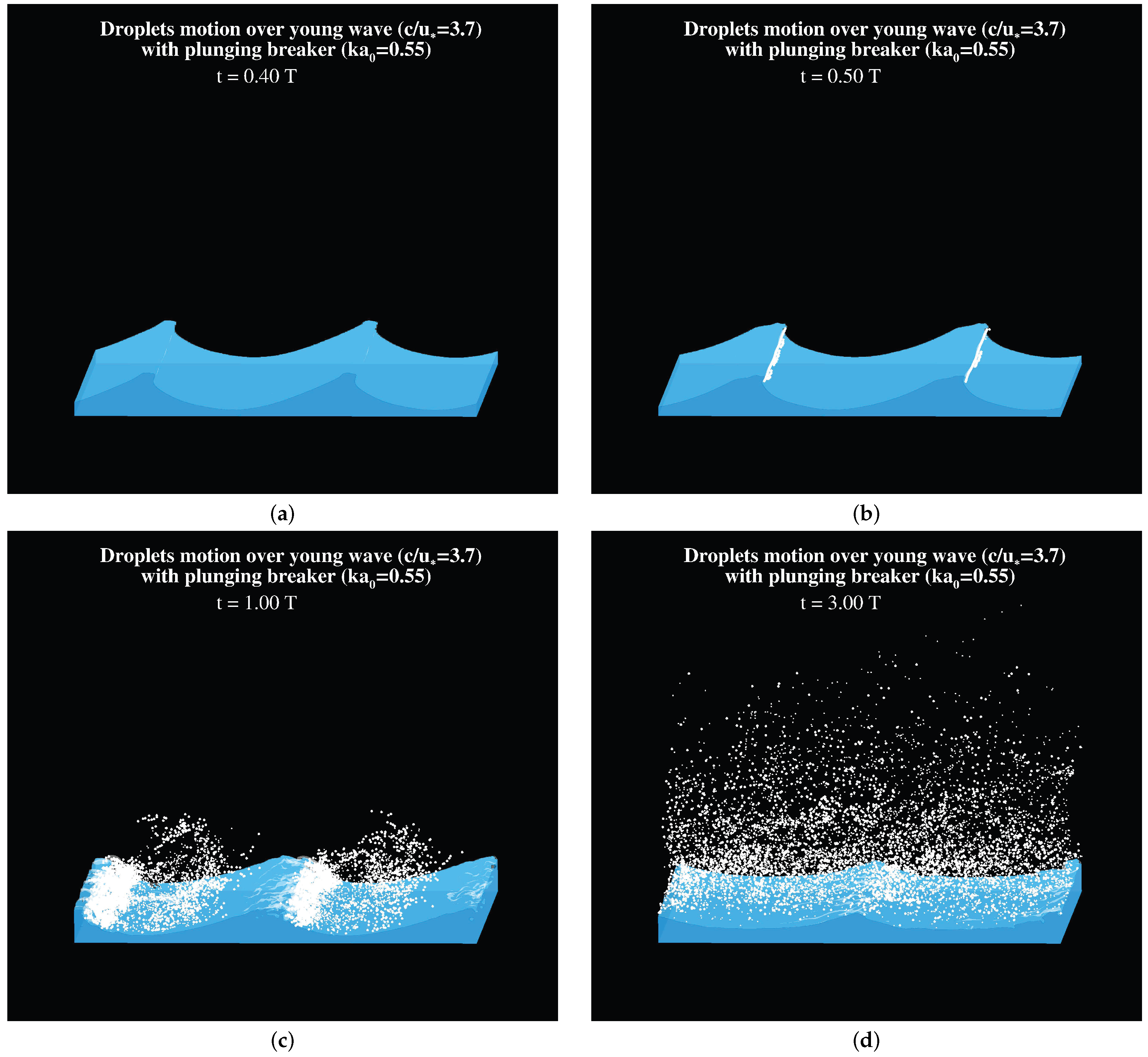
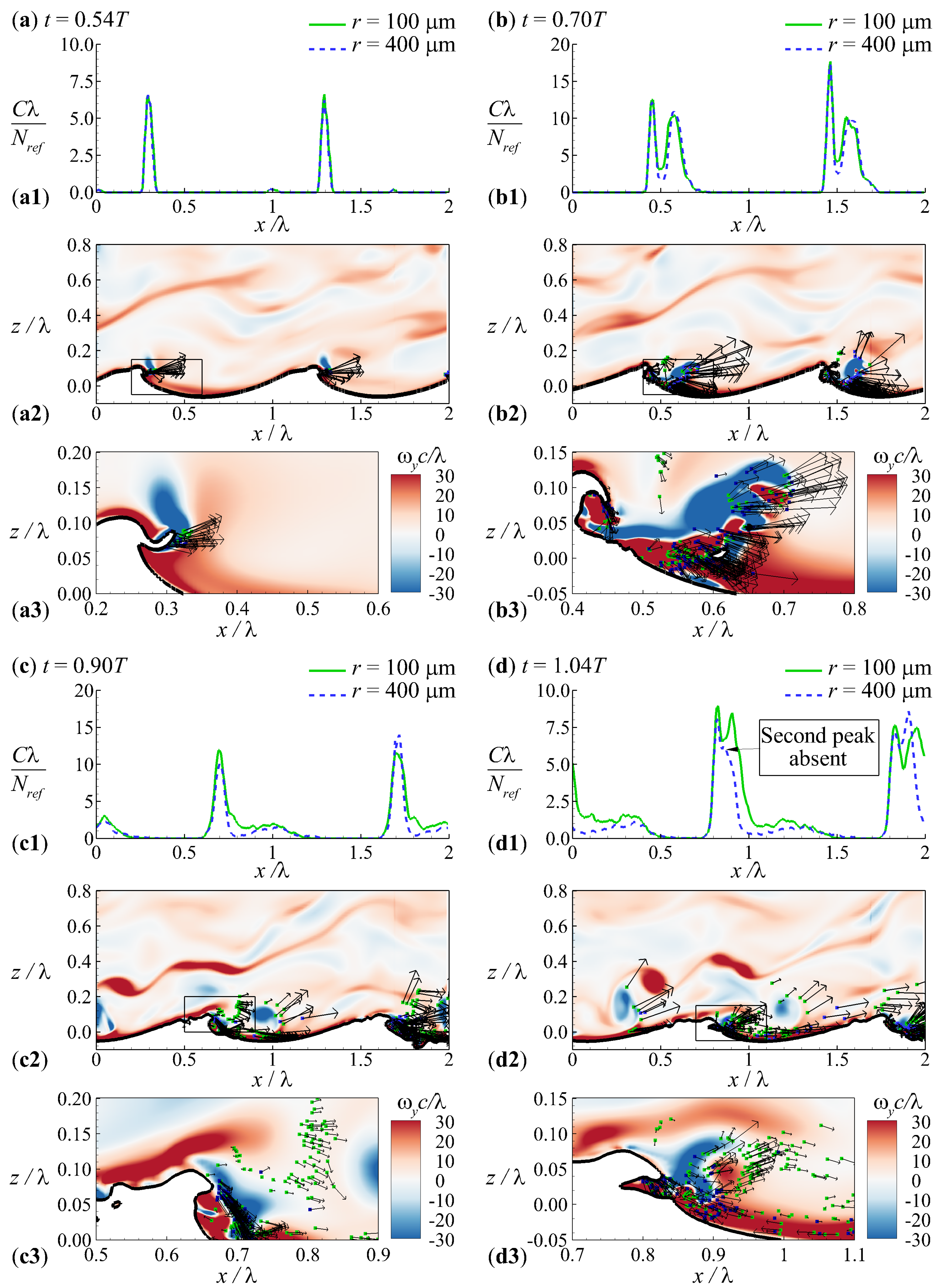

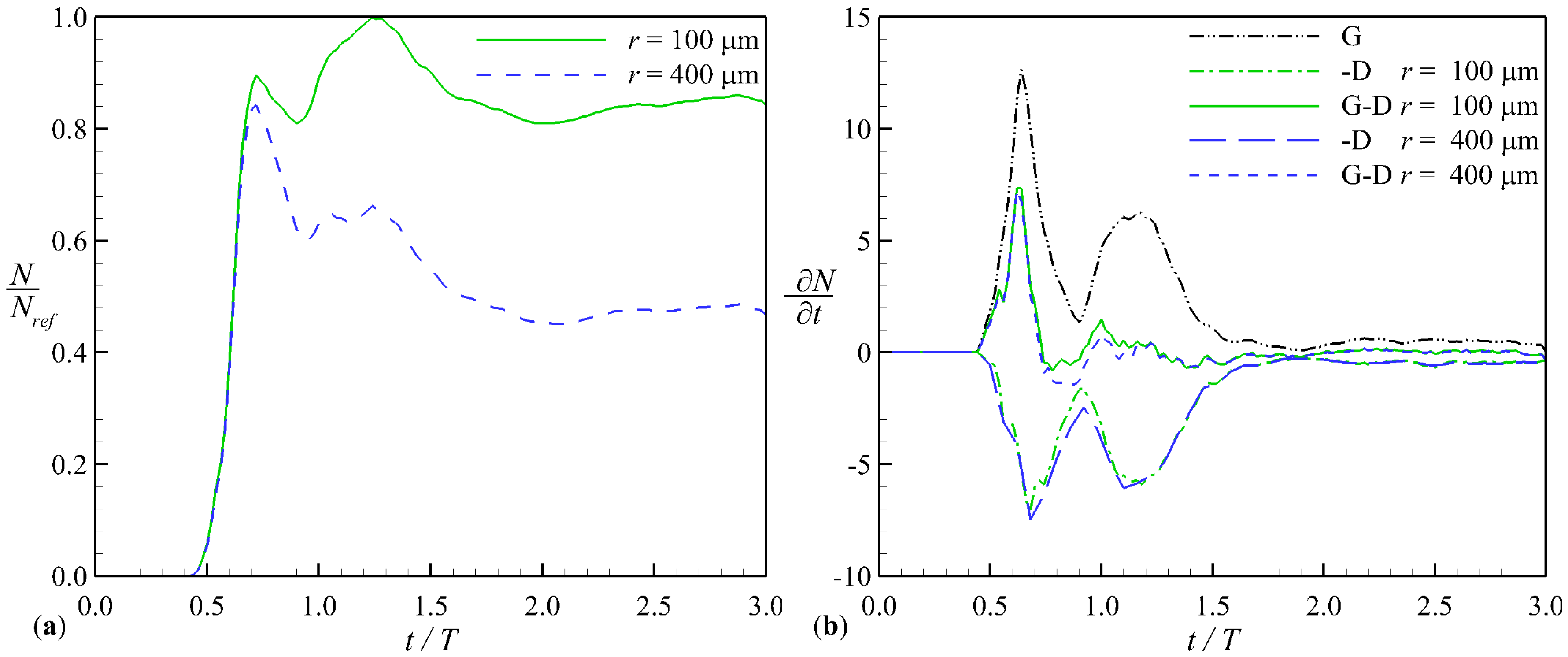

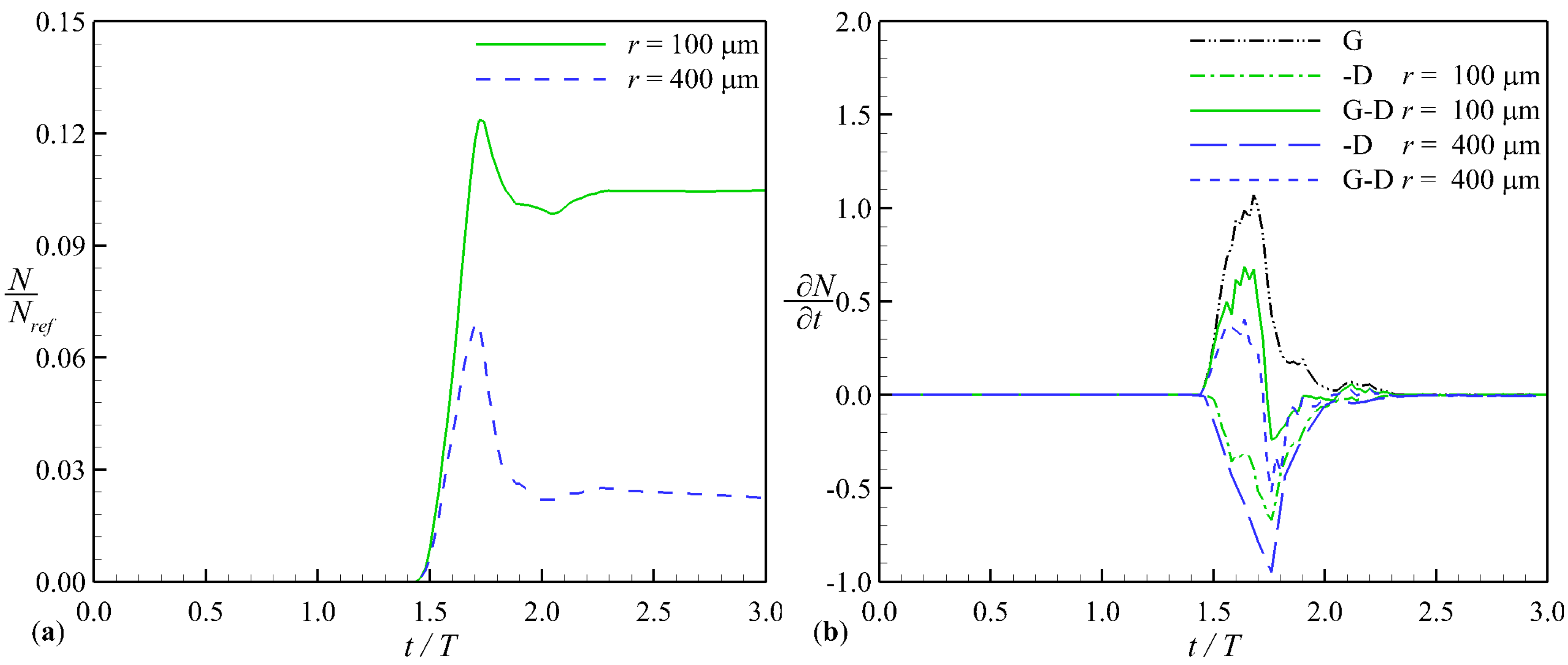
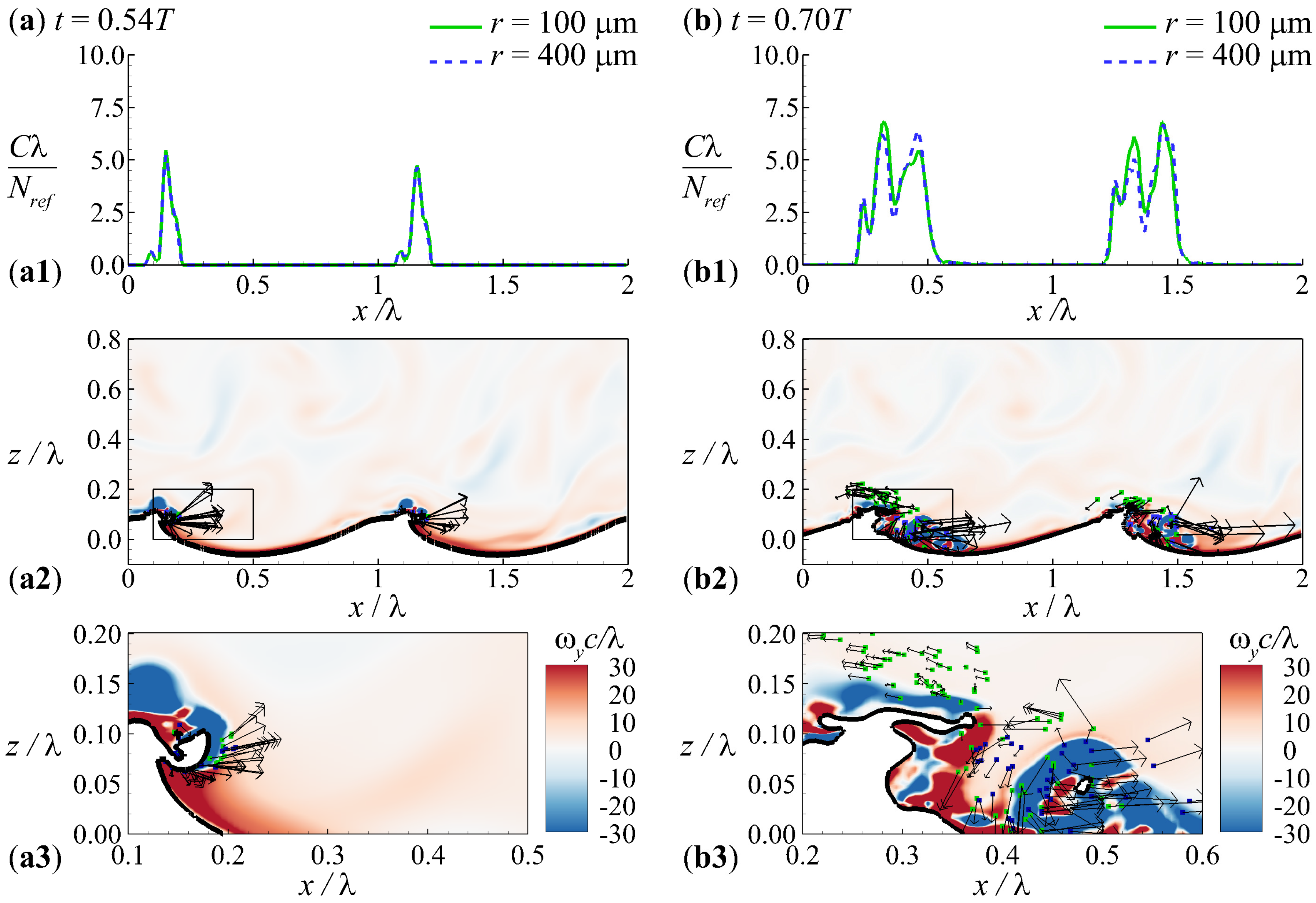
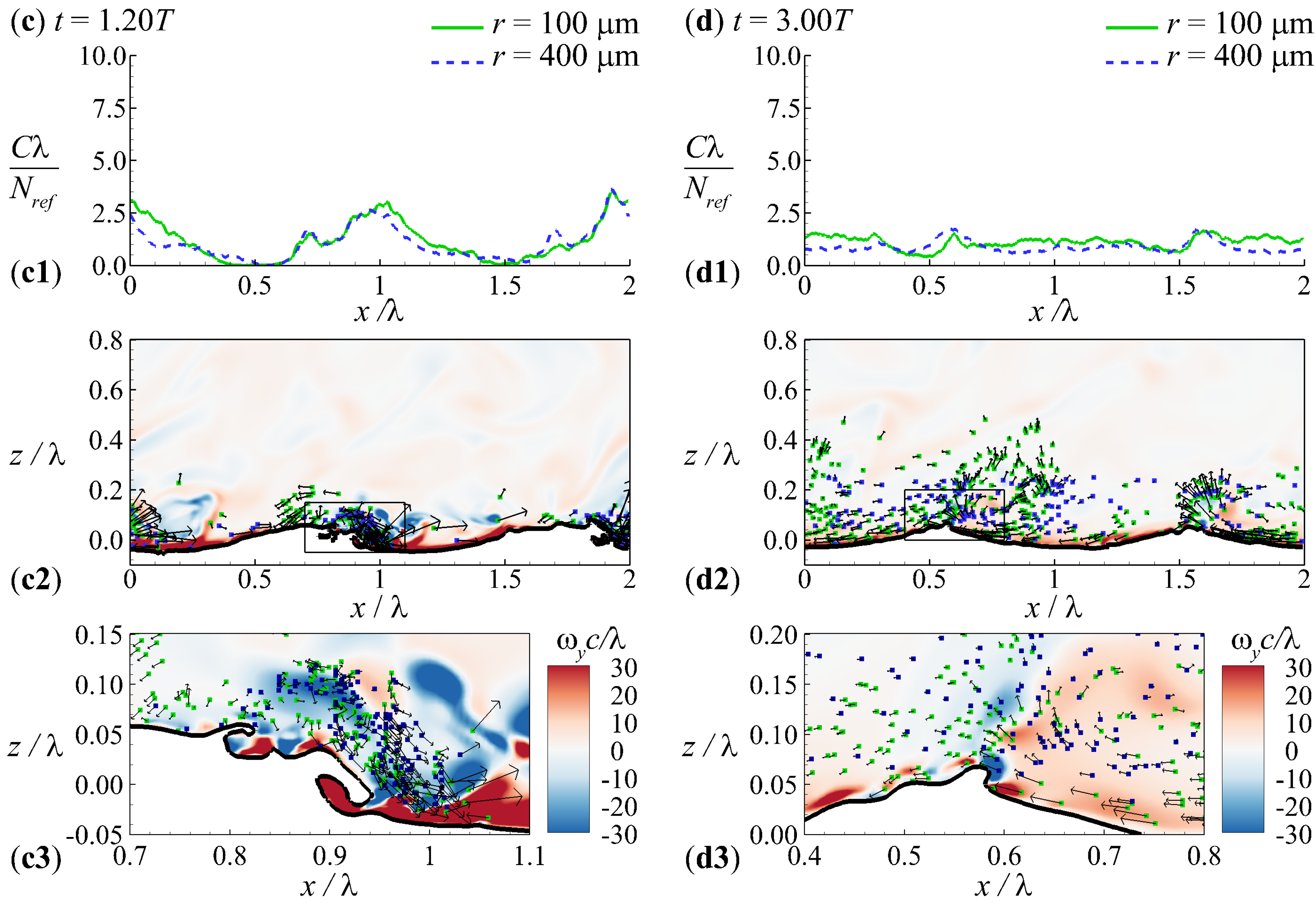
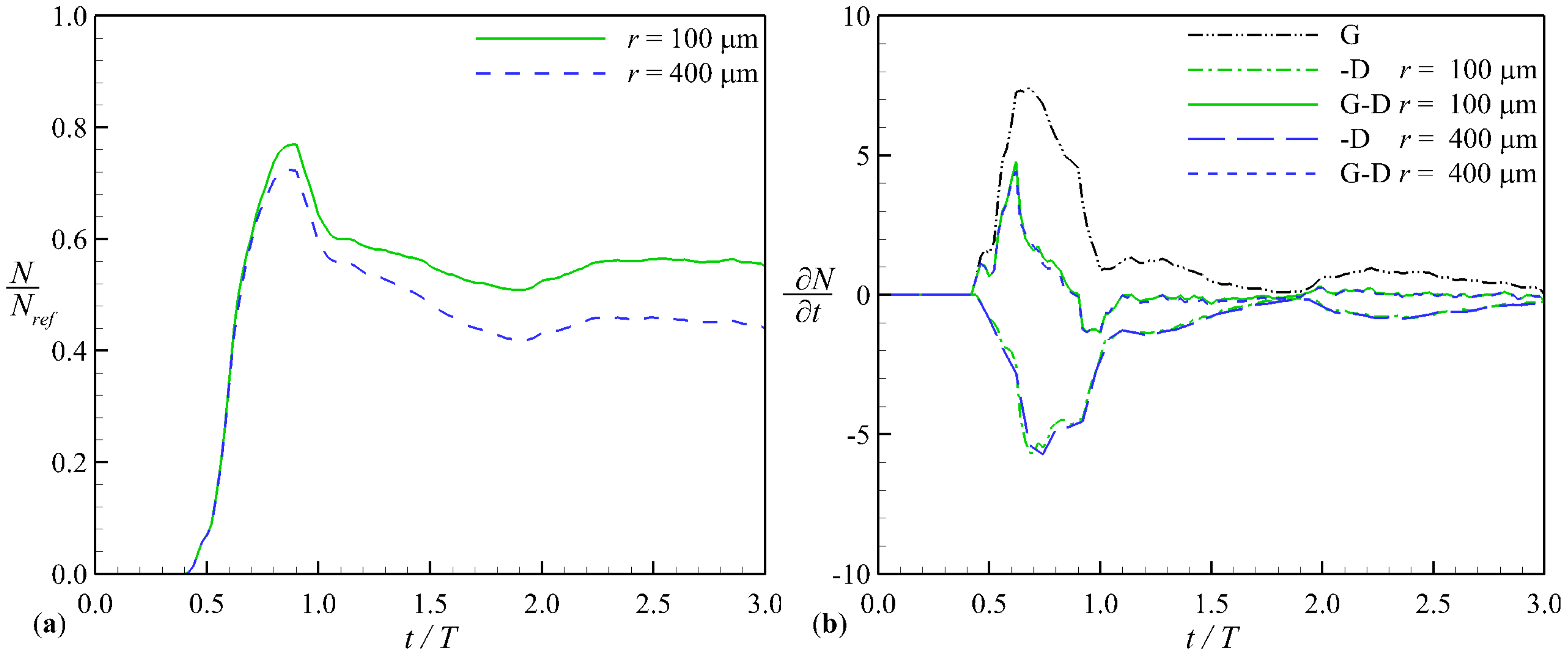
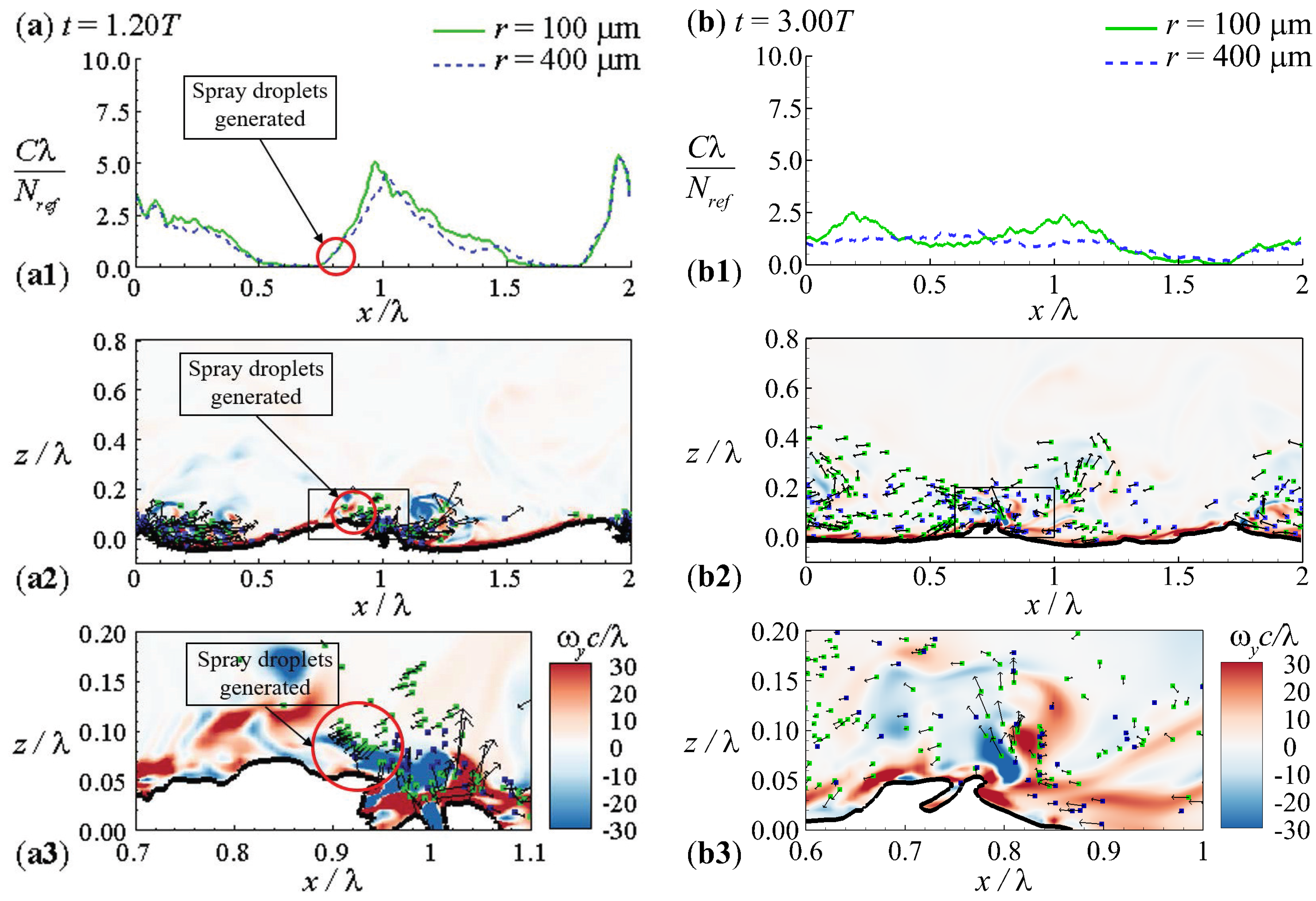
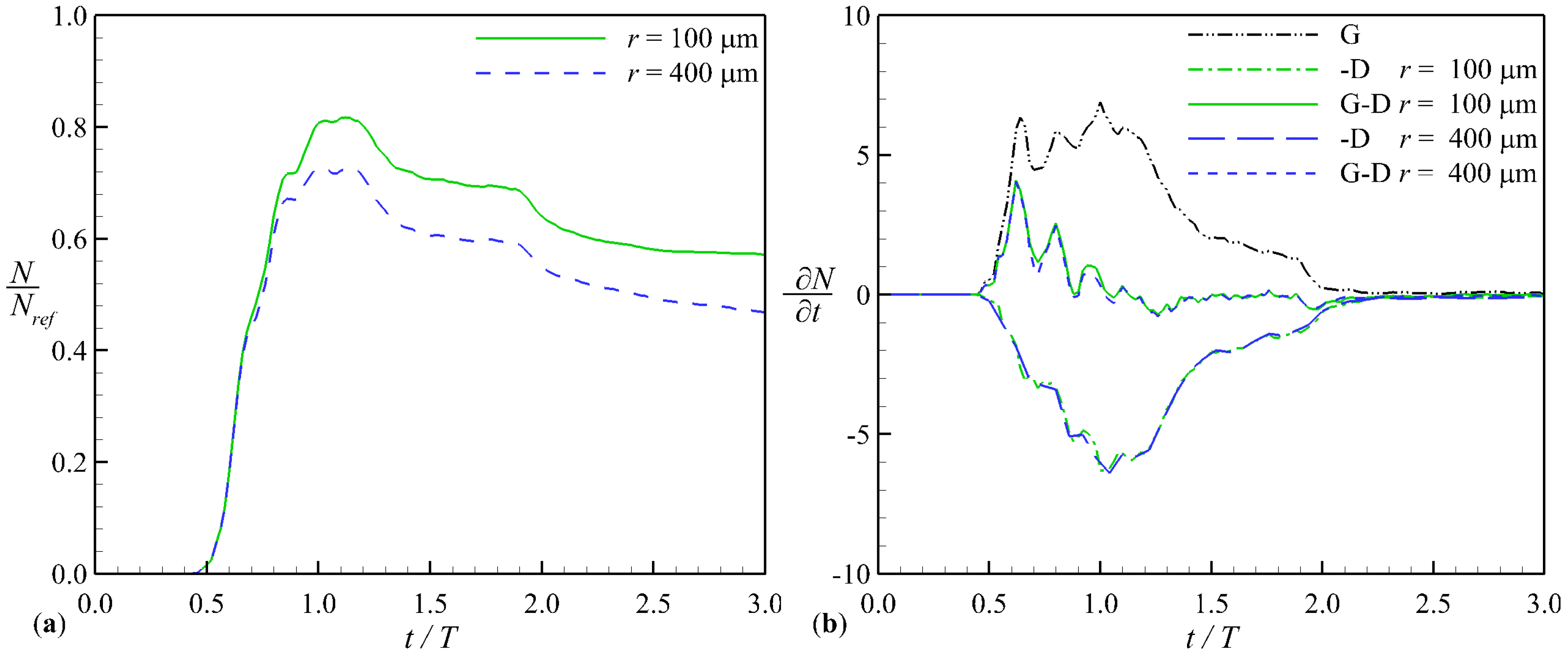

| Dimensional Parameters | ||||||
| Case | ||||||
| A55 | 5 | 0.88 | 3.19 | 0.86 | 25.8 | 1.57 |
| A38 | 0.60 | 2.99 | 0.81 | 24.1 | 1.68 | |
| B55 | 0.88 | 3.19 | 0.27 | 8.1 | 1.57 | |
| C55 | 0.88 | 3.19 | 0.12 | 3.4 | 1.57 | |
| Dimensional Parameters | ||||||
| Case | ||||||
| A55 | 1.205 | 998 | 1.87 | |||
| A38 | 1.76 | |||||
| B55 | 0.59 | |||||
| C55 | 0.26 | |||||
| Dimensionless Parameters | ||||||
| Case | ||||||
| A55 | 3.7 | 0.55 | 180 | |||
| A38 | 3.7 | 0.38 | ||||
| B55 | 12.0 | 0.55 | ||||
| C55 | 27.7 | 0.55 | ||||
© 2017 by the authors. Licensee MDPI, Basel, Switzerland. This article is an open access article distributed under the terms and conditions of the Creative Commons Attribution (CC BY) license (http://creativecommons.org/licenses/by/4.0/).
Share and Cite
Tang, S.; Yang, Z.; Liu, C.; Dong, Y.-H.; Shen, L. Numerical Study on the Generation and Transport of Spume Droplets in Wind over Breaking Waves. Atmosphere 2017, 8, 248. https://doi.org/10.3390/atmos8120248
Tang S, Yang Z, Liu C, Dong Y-H, Shen L. Numerical Study on the Generation and Transport of Spume Droplets in Wind over Breaking Waves. Atmosphere. 2017; 8(12):248. https://doi.org/10.3390/atmos8120248
Chicago/Turabian StyleTang, Shuai, Zixuan Yang, Caixi Liu, Yu-Hong Dong, and Lian Shen. 2017. "Numerical Study on the Generation and Transport of Spume Droplets in Wind over Breaking Waves" Atmosphere 8, no. 12: 248. https://doi.org/10.3390/atmos8120248





